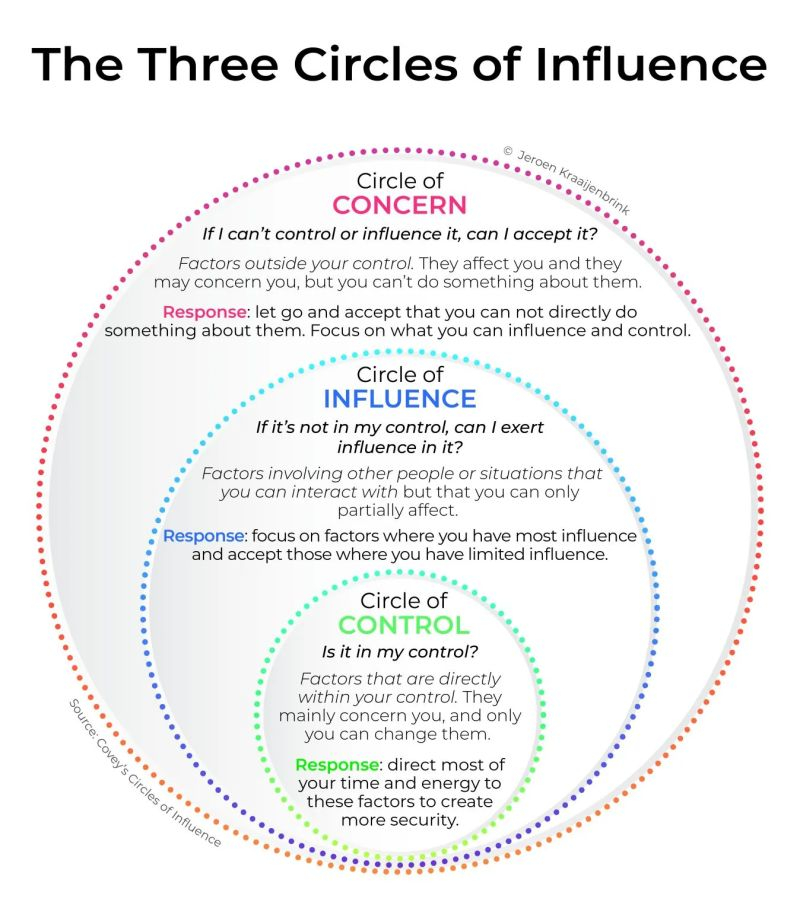Stephen Covey has helped us with a lot of insightful ideas, concepts and models. One of them is the Circle of Influence Model, also known as the CIA model along the three main actions resulting from it: Control, Influence, Accept.
It distinguish three types of issues or worries that you may have and that ask for a different response:
The Circle of CONTROL → Control
Key question: is it in my control?
Description: the factors that are directly within your control. They mainly concern you personally, and you (and often only you) can change them.
Examples: thoughts, behaviors, mindset, actions, skills, mistakes
Response: direct most of your time and energy to these factors, this will minimize feelings of overwhelm and makes you feel in control.
The Circle of INFLUENCE → Influence
Key question: if it’s not in my control, can I exert influence in it?
Description: factors involving other people or situations that you can interact with but that you can only partially affect.
Examples: relationships, commitments, job, roles, positions
Response: focus on those factors that you have most influence on and accept the factors on which your influence is limited.
The Circle of CONCERNS → Accept
Key question: If I can’t control or influence it, can I accept it?
Description: the factors outside your control. They affect you and they may concern you, but you can’t do something about them.
Examples: weather, economy, war, legislation, virus outbreak
Response: let go and accept that you can not directly do something about them. Focus on what you can influence and control.
The categories are not fixed and they depend on your position. What is merely in the Circle of Concern of most people, such as the economy for example, is in the Circle of Influence of politicians.
This means that the Three Circles of Influence look different for every individual person. But exactly that makes it such a powerful model. Because you can immediately apply it to yourself, or to your team or organization.
One way to do this smartly is to make an inventory of all issues and topics you are currently concerned about; that you worry about and keep your head busy. Once you have the list you can then categorize them in the three categories and follow the brief recommendations given above.
The main effect this should have is that you feel more in control and spend your time more effectively on those factors where you can actually make a difference.
Do you spend your time and energy on the right factors? "
It distinguish three types of issues or worries that you may have and that ask for a different response:
The Circle of CONTROL → Control
Key question: is it in my control?
Description: the factors that are directly within your control. They mainly concern you personally, and you (and often only you) can change them.
Examples: thoughts, behaviors, mindset, actions, skills, mistakes
Response: direct most of your time and energy to these factors, this will minimize feelings of overwhelm and makes you feel in control.
The Circle of INFLUENCE → Influence
Key question: if it’s not in my control, can I exert influence in it?
Description: factors involving other people or situations that you can interact with but that you can only partially affect.
Examples: relationships, commitments, job, roles, positions
Response: focus on those factors that you have most influence on and accept the factors on which your influence is limited.
The Circle of CONCERNS → Accept
Key question: If I can’t control or influence it, can I accept it?
Description: the factors outside your control. They affect you and they may concern you, but you can’t do something about them.
Examples: weather, economy, war, legislation, virus outbreak
Response: let go and accept that you can not directly do something about them. Focus on what you can influence and control.
The categories are not fixed and they depend on your position. What is merely in the Circle of Concern of most people, such as the economy for example, is in the Circle of Influence of politicians.
This means that the Three Circles of Influence look different for every individual person. But exactly that makes it such a powerful model. Because you can immediately apply it to yourself, or to your team or organization.
One way to do this smartly is to make an inventory of all issues and topics you are currently concerned about; that you worry about and keep your head busy. Once you have the list you can then categorize them in the three categories and follow the brief recommendations given above.
The main effect this should have is that you feel more in control and spend your time more effectively on those factors where you can actually make a difference.
Do you spend your time and energy on the right factors? "
Stephen Covey has helped us with a lot of insightful ideas, concepts and models. One of them is the Circle of Influence Model, also known as the CIA model along the three main actions resulting from it: Control, Influence, Accept.
It distinguish three types of issues or worries that you may have and that ask for a different response:
The Circle of CONTROL → Control
Key question: is it in my control?
Description: the factors that are directly within your control. They mainly concern you personally, and you (and often only you) can change them.
Examples: thoughts, behaviors, mindset, actions, skills, mistakes
Response: direct most of your time and energy to these factors, this will minimize feelings of overwhelm and makes you feel in control.
The Circle of INFLUENCE → Influence
Key question: if it’s not in my control, can I exert influence in it?
Description: factors involving other people or situations that you can interact with but that you can only partially affect.
Examples: relationships, commitments, job, roles, positions
Response: focus on those factors that you have most influence on and accept the factors on which your influence is limited.
The Circle of CONCERNS → Accept
Key question: If I can’t control or influence it, can I accept it?
Description: the factors outside your control. They affect you and they may concern you, but you can’t do something about them.
Examples: weather, economy, war, legislation, virus outbreak
Response: let go and accept that you can not directly do something about them. Focus on what you can influence and control.
The categories are not fixed and they depend on your position. What is merely in the Circle of Concern of most people, such as the economy for example, is in the Circle of Influence of politicians.
This means that the Three Circles of Influence look different for every individual person. But exactly that makes it such a powerful model. Because you can immediately apply it to yourself, or to your team or organization.
One way to do this smartly is to make an inventory of all issues and topics you are currently concerned about; that you worry about and keep your head busy. Once you have the list you can then categorize them in the three categories and follow the brief recommendations given above.
The main effect this should have is that you feel more in control and spend your time more effectively on those factors where you can actually make a difference.
Do you spend your time and energy on the right factors? "
0 Comments
0 Shares
479 Views
0 Reviews



